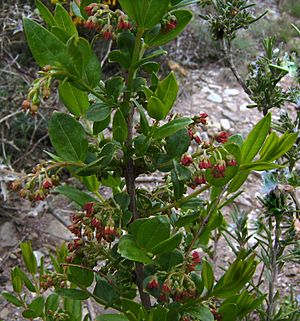Coriaria facts for kids
Quick facts for kids Coriaria |
|
|---|---|
 |
|
| Coriaria arborea, a tutu plant | |
| Scientific classification | |
| Kingdom: | |
| Division: | |
| Class: | |
| Order: | |
| Family: |
Coriariaceae
|
| Genus: |
Coriaria
|
| Species | |
|
See text. |
|
| Synonyms | |
Coriaria is a special group of plants, also known as a genus. It is the only group of plants in its family, called Coriariaceae. There are about 15 to 20 different kinds, or species, of Coriaria plants known today.
Contents
What Coriaria Plants Look Like
Most Coriaria plants are shrubs, which are like large bushes. Some are subshrubs, which are smaller bushes, or even small trees. Their leaves are simple and grow in pairs or in circles around the stem. Each leaf usually has 3 to 9 main veins starting from its base.
The fruits of Coriaria plants look like berries. But they are actually tiny nuts called achenes. These nuts are hidden inside enlarged, colorful petals. The seeds inside the nuts are poisonous and should not be eaten. However, for some species, especially those from New Zealand, the colorful petals that cover the true fruits can be eaten.
Many Coriaria plants can help the soil by taking nitrogen from the air. They do this with the help of tiny bacteria called Frankia that live in their roots.
Where the Name Coriaria Comes From
The name of the genus Coriaria was first given by a famous scientist named Linnaeus in 1753. He wrote about it in his book Species Plantarum. The main plant he used to describe the group was Coriaria myrtifolia.
The name Coriaria comes from the Latin word corium, which means "leather". This is because these plants contain a substance called tannin. Tannin is used to turn animal skins into leather.
In New Zealand, the different kinds of Coriaria plants are known by the Māori name "tutu".
Where Coriaria Plants Grow
Coriaria plants grow in some very interesting places around the world. You can find them in five main regions:
- Around the western Mediterranean area. This includes countries like Portugal, Spain, France, Italy, Morocco, and Algeria.
- In southern and eastern Asia, from Pakistan all the way to central China.
- On islands in eastern Asia, such as Japan, Taiwan, and the Philippines.
- On islands in the Pacific Ocean, like New Guinea, Samoa, Fiji, Vanuatu, and New Zealand. New Zealand has the most different types of Coriaria plants.
- In America, from Mexico down to Peru, and also in Chile and western Argentina.

How People Use Coriaria Plants
Some types of Coriaria plants are used to make leather from the skins of animals like cattle and horses.
In New Zealand, the Māori people make a juice from the "fruits" (which are actually the colorful petals) of the "tutu" plant. In Chile, the nuts from some Coriaria plants are used to make poison for rats and mice.
Because they grow many bright, colorful fruits, some Coriaria plants are also grown as ornamental plants. This means people plant them in gardens just because they look pretty.
Different Kinds of Coriaria
There are about 17 different species of Coriaria plants. Some of these include:
- Coriaria angustissima found in New Zealand's South Island.
- Coriaria arborea found on the Chatham and Kermadec islands in New Zealand.
- Coriaria japonica found in Taiwan and Japan.
- Coriaria myrtifolia found in the western Mediterranean.
- Coriaria ruscifolia found from New Guinea to the South Pacific, and from Mexico to southwestern Argentina.
See also
 In Spanish: Coriaria para niños
In Spanish: Coriaria para niños

